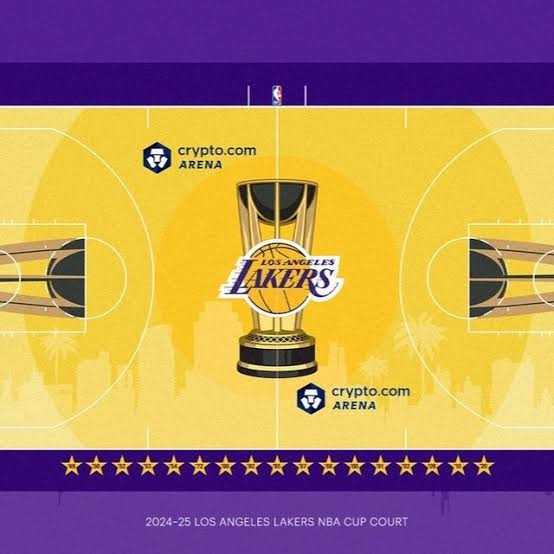The NBA Cup (formerly the In-Season Tournament) has introduced one of the most visually striking innovations in professional basketball: exotic hardwood courts designed specifically for Cup games. These courts don’t just look different—they are built to signal that these matchups stand apart from regular-season games, giving the tournament its own identity, energy, and broadcast appeal.
In this guide, we break down what makes these courts unique, how they are designed, their purpose, and player reactions.
What Makes the NBA Cup Courts “Exotic”?
Unlike traditional NBA surfaces, which typically use standard finished maple in natural wood tones, the NBA Cup courts are highly customized, fully painted hardwood floors featuring:
- Full-floor color gradients based on each team’s brand identity
- Bold, statement color aprons using Nike Statement Edition uniform colors
- Emirates NBA Cup trophy logos at center court and on the free-throw lanes
- Stylized typography, symbols, and city landscape elements
- A 5×5 “mosaic grid” pattern symbolizing five players and the five teams in each Cup group
These aren’t just cosmetic touches—every court is designed to look like a one-of-a-kind hardwood artwork that visually reinforces the importance of Cup games.
Goals of the NBA Cup Court Design
The NBA introduced these courts to accomplish several goals:
1. Create a Distinct Tournament Atmosphere
Just like March Madness or EuroLeague Final Four, the NBA wanted its tournament games to feel special. The courts instantly signal to fans—this is not a normal regular-season matchup.
2. Stand Out on Broadcast and Streaming
Bold colors and unique aesthetics make Cup games visually memorable on TV and streaming platforms such as ESPN, TNT, and NBA League Pass.
3. Strengthen Team and League Branding
Courts incorporate local culture, franchise history, and Cup-specific trophy branding, combining identity with competition.
Signature Court Features Seen Across the League
Here are recurring design elements that distinguish NBA Cup hardwoods from regular courts:
| Design Element | Meaning / Purpose |
| Full painted hardwood | Covered in team-specific colors instead of natural maple wood grain |
| Cup trophy at center court | Visual symbol of tournament identity |
| Gradient floor backgrounds | Represent the flow of competition and franchise evolution |
| 5×5 grid pattern overlay | Represents five players and five teams in each group |
| Nike Statement apron colors | Tie court design to tournament uniform branding |
| Sideline wordmarks & slogans | Showcase city, culture, or motivational phrases |
| Distinct free-throw lane artwork | Often featuring trophy graphics or team iconography |
How the Courts Are Designed
NBA Cup courts are created in collaboration with the league and artist Victor Solomon, known for mixing fine art with basketball culture. His design philosophy blends:
- Geometric symbolism (grids, mosaics, diagonal layers)
- Championship-inspired detailing
- Heritage elements tied to each team’s city and culture
Each court must also meet NBA hardwood performance and safety standards, even though every surface is fully painted.
Player and Fan Reactions
While the courts are visually stunning, reactions have been mixed:
Praise
- Great for branding and broadcast: Fans love the dramatic visuals on TV and social media.
- Playoff-style atmosphere: Courts make the stakes feel higher, even in early-season games.
- Social media momentum: Has helped boost Cup viewership, highlights, and engagement.
Concerns
- Slipperiness and safety: Some players reported the custom-painted surfaces felt slick.
- Visual distractions: Certain courts—especially those with bright yellow, neon, or red tones—were criticized for being too intense for viewing.
Some notable player feedback included concerns from Luka Dončić and Jaylen Brown, who felt certain floors were “slippery” and “harder for visibility.”
Why the Exotic Courts Matter for the NBA Cup’s Future
The NBA Cup aims to become a signature midseason event—much like bowl games in soccer or global tournament-style competitions. The custom courts help:
- Differentiate Cup games from the traditional 82-game season
- Build hype similar to playoff basketball—months earlier
- Expand branding opportunities for teams, Nike uniforms, and Emirates (Cup sponsor)
- Enhance social media impact, ticket sales, and television ratings
As the tournament grows, courts may evolve with augmented graphics, LED floor designs, or interactive surfaces—but the core concept will remain: Cup games should look and feel unmistakably different.
Final Takeaway
The NBA Cup’s exotic hardwood courts are more than just eye candy—they are a visual storytelling tool and a branding powerhouse. Built to enhance atmosphere, player perception, fan experience, and global visibility, these bold floors help transform regular-season games into tournament-style events with higher stakes and bigger identity.

